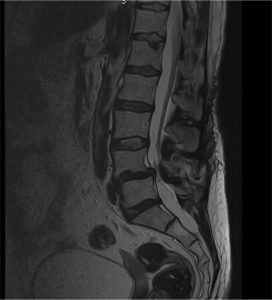Inside the lumbar vertebrae there is a canal the nerve roots grouped inside the dural sac pass through. Whenever there is a reduction in the size of this canal this causes a stereotyped neurological profile known as spinal stenosis syndrome.
Clinical signs:
The patient complains of sciatica, normally bilateral even though it may be more intense in one extremity, especially when making any type of effort. Neurogenic claudication is also characteristic, patient presents fatigability and loss of strength in the legs forcing them to stop after making very little effort such as walking 100 metres.
It is important to differentiate this profile from vascular claudication, where pathology is located in the arteries of the legs, as the therapeutic approach will be different.
Diagnosis:
Additional tests such as EMG or imaging aid in confirming the diagnosis, while at the same time being of enormous importance when planning the surgical operation.
Treatment:
The therapeutic approach will be surgical, the rear part of the spinal canal will be opened by means of laminectomy to prevent compression of the nerve roots and so obtain an improvement in the neurogenic claudication and sciatica.



